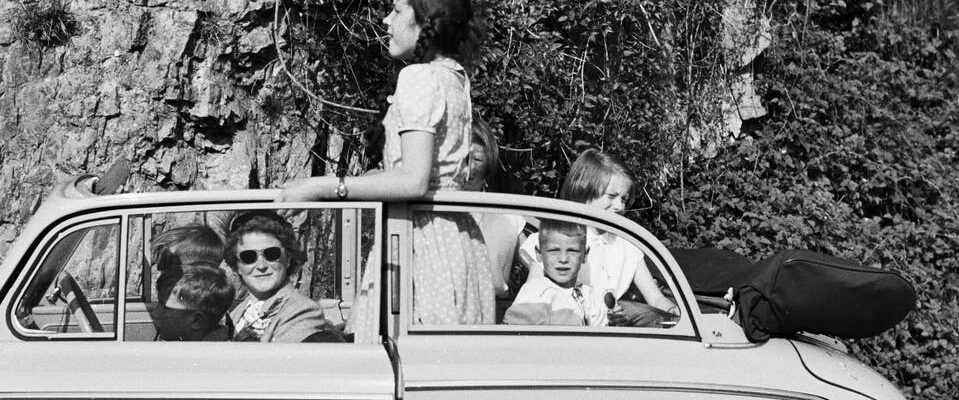Michael Aschwanden / Uri State Archives
The development of Axenstrasse is a story of upswing and success. A story of fascination and pleasure. And a story of suffering and tragedy. This was demonstrated again this week.
On average, 200 people die on Swiss roads every year – we only remember very few accidents. Fatal road accidents are usually treated as short reports in the media. They happen too often, we have become too used to them.
The car accident, which has kept Switzerland in suspense for days, is different: last Sunday’s accident on Axenstrasse, when a man broke through the railing with his car, fell about 50 meters into Lake Lucerne and only stopped at a depth of 182 meters came.
Where is the wrecked car? How can he be recovered? Why is there no crash barrier at this point?
“One of the most beautiful driving and fun parts”
The Axenstrasse, which was carved into the rugged rock above Lake Uri around 160 years ago, exerts a fascination like few other traffic routes.
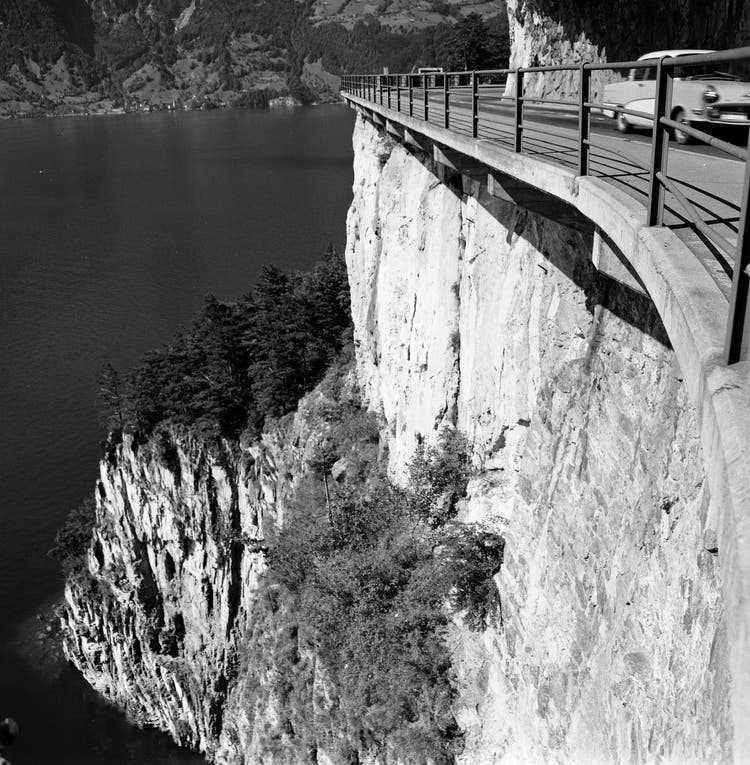
The Axeneck near the Tellsplatte in 1945.
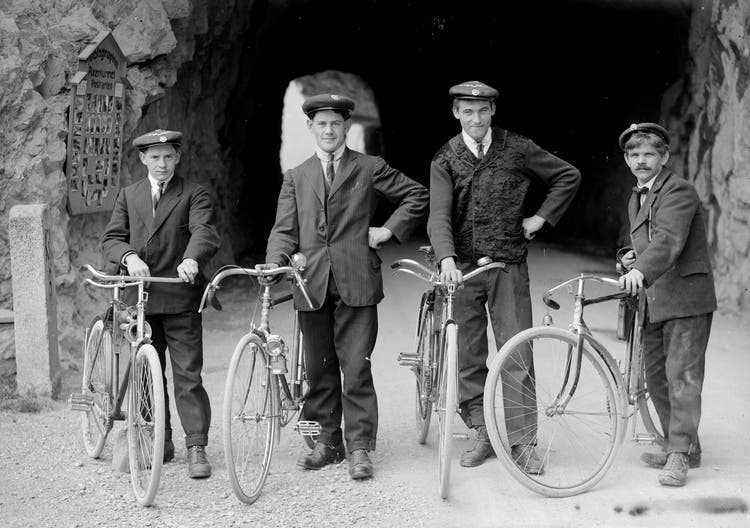
In the 1920s, four boys rode their bicycles along Axenstrasse. They could be members of a cycling club.
Hundreds of workers, mostly from Italy and Austria, blasted the road through the rock with black powder in the mid-19th century. Since opening in the summer of 1865, thousands of locals have felt a little closer to the wide world. Over the past 150 years, millions of tourists have passed the Axenstrasse, which meanders through the mountain, on their journey from Zurich to Ticino and marveled at the view of the crystal-clear Lake Uri. And dozens have died along the way.
The euphoria was already great before the opening. “Once the Axenstrasse is completed, which will soon be the case over the course of this summer, it will undoubtedly be one of the most beautiful rides and fun parts in our Swiss fatherland, which we are already drawing attention to with good reason,” describes a Journalist from the «Neue Zürcher Zeitung» on a May day in 1865.
While the author reveled in the beauty of the building, where “the art-loving wanderer suddenly thinks he is in the cloister of an ancient abbey”, the new Axenstrasse had a much more mundane meaning for the population of the cantons of Uri and Schwyz. For the first time, a road connected the south via the Gotthard with the north, which many in the region hoped would bring a better future. While Flüelen could only be reached by boat from the north, from 1865 travelers could cover the entire route between Zurich and Milan without interruption.
Popular tourist destination
The hopes placed in tourism in the cantons of Uri and Schwyz with the opening of the road were not disappointed in the first few decades. From the middle of the 19th century, central Switzerland experienced a major boom in tourism – not least thanks to the impressive pictures of the Axenstrasse with its galleries.
A tourist guide from the Lucerne Tourist Office from the turn of the century praised “the incomparable walk on the Axenstrasse” in the highest tones. It can “indeed be described as classic”, so much so that “not a single visitor to Urschweiz fails to walk it”.
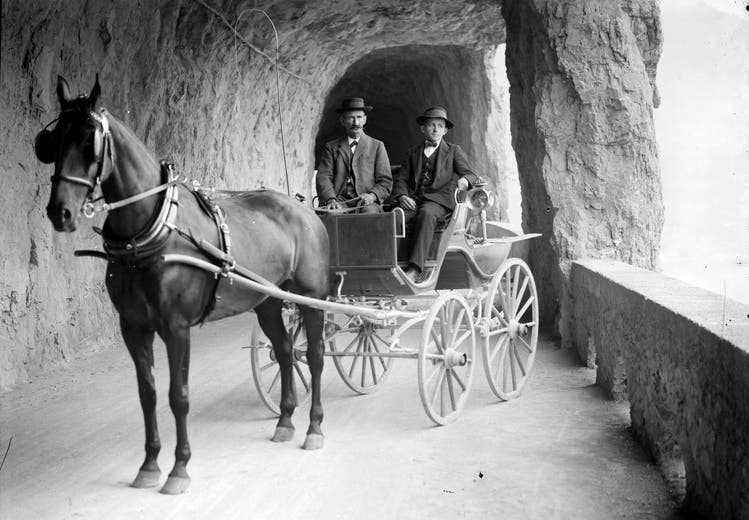
Two men pose in a carriage circa 1920.
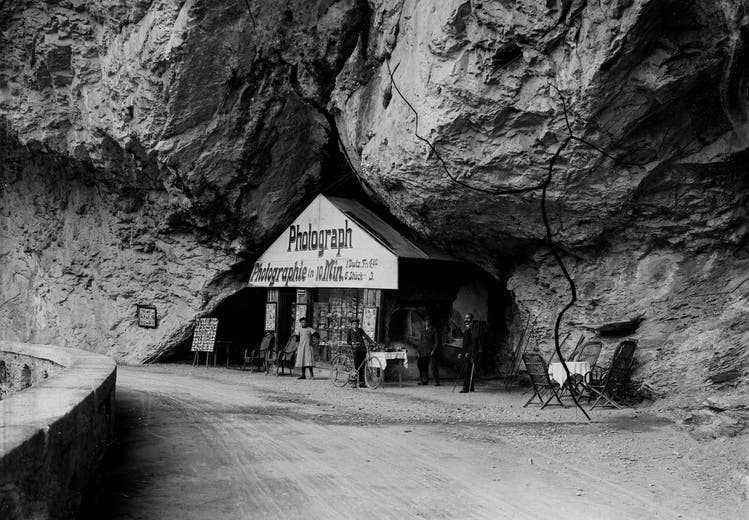
Michael Aschwanden photographed thousands of people on Axenstrasse. For more than twenty years he ran a photo kiosk on the street.
‘Nothing happier than driving through her picture gallery in a light summer carriage; but it is also a pleasure to hike through them», can be read in a book about Lake Lucerne from 1898.
Because of such unctuous words, the tourists came – and with them the money. Quite a few locals found a new or additional income in the hotels and restaurants, with the newly built railways in the region or with small services along the Axenstrasse.
Photographs show fascination
Those who enjoyed the trip above Lake Uri in the late 19th century in a carriage could soon do so in a motorized vehicle. Countless are the surviving photographs of tourists having their pictures taken in the galleries in their automobiles. The fascination that still emanates from the street today was passed on from generation to generation.
A dozen photographs cost 4 francs 80 at a kiosk in the 1930s. They were taken there by Michael Aschwanden, whose photographs are an important testimony to tourism in the early 20th century. Neither officers in the company car, day trippers from Switzerland and abroad nor wedding parties took the opportunity to immortalise themselves on “one of the most beautiful journeys” in Switzerland.
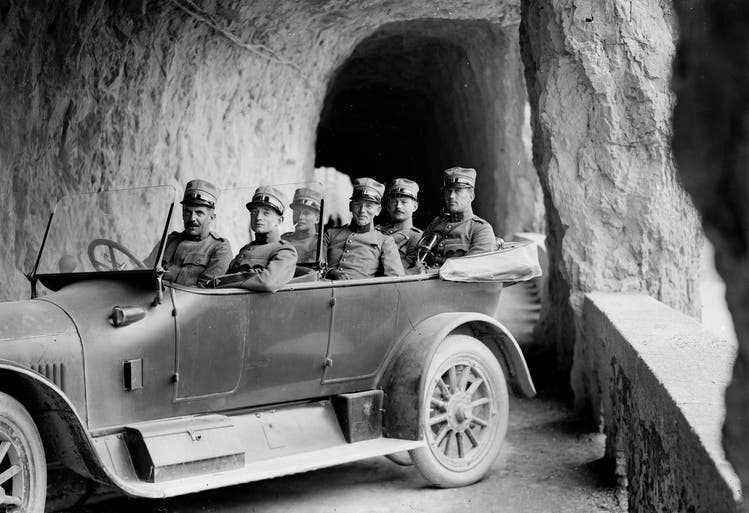
A group of officers enjoys the drive down Axenstrasse in 1920.
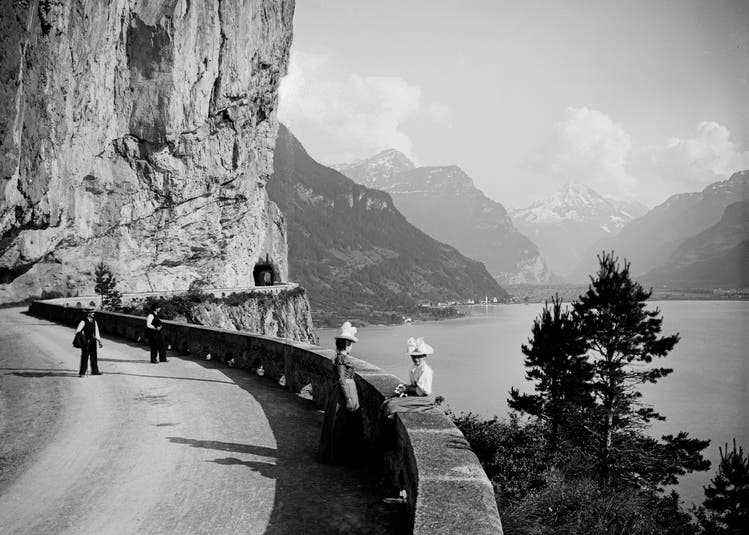
The Axenstrasse has enjoyed great popularity as an excursion destination for decades. (View towards Flüelen and Bristenstock, around 1911.)
But it wasn’t just the impressive view that fueled the fascination. With the increased volume of traffic, the public became more aware of the dangers of driving through the galleries of Axenstrasse. Although man had conquered the rock, there were always events that made it clear that nature was not defeated.
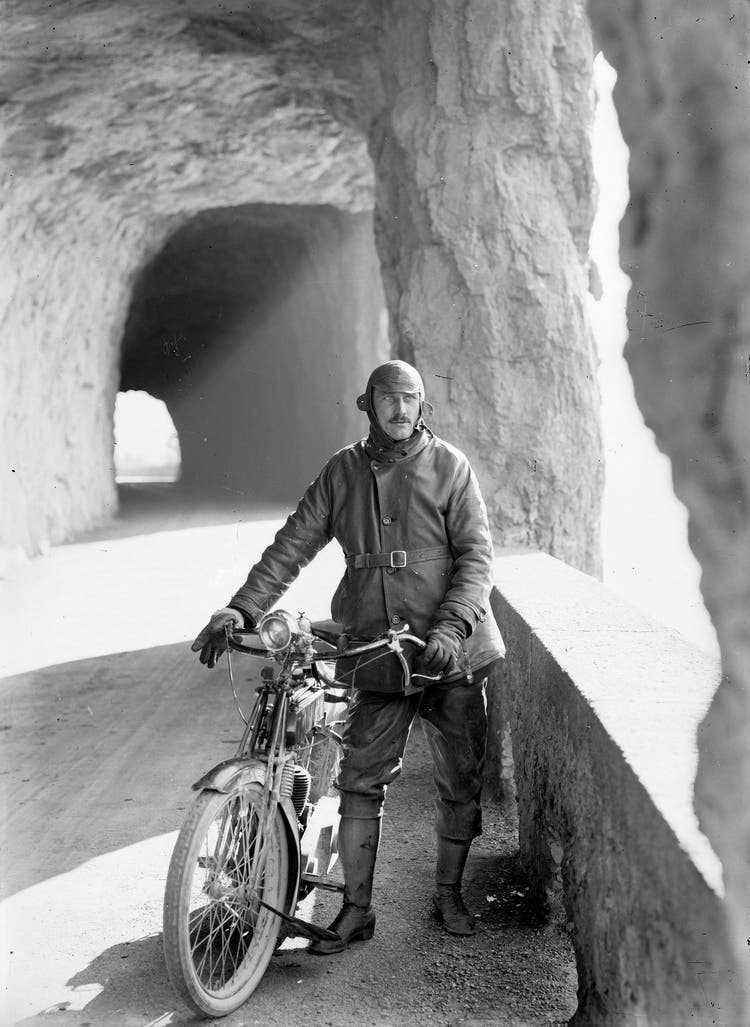
Motorized traffic increased from the turn of the century. (A man in leather clothes and with motorcycles around 1925.)
Increasing traffic, increasing dangers
A rockfall in January 1932 made it clear how fragile the supposed safety on the road really was. Around 6,000 cubic meters of debris thundered into the valley between Flüelen and Sisikon, destroying the forest and the Axenstrasse. Luckily, the rockfall happened early in the morning, so no one was hurt. In the spring of the same year, there was another danger due to landslides, which is why the road had to be closed for months.
The main artery of tourism in Uri was suddenly severed. “The silence that reigned across the country, even on Sundays, was worrying,” wrote a local newspaper.
Even if traffic was able to resume at Pentecost 1932: longer closures, coupled with security work and renovations, were henceforth firmly associated with Axenstrasse.
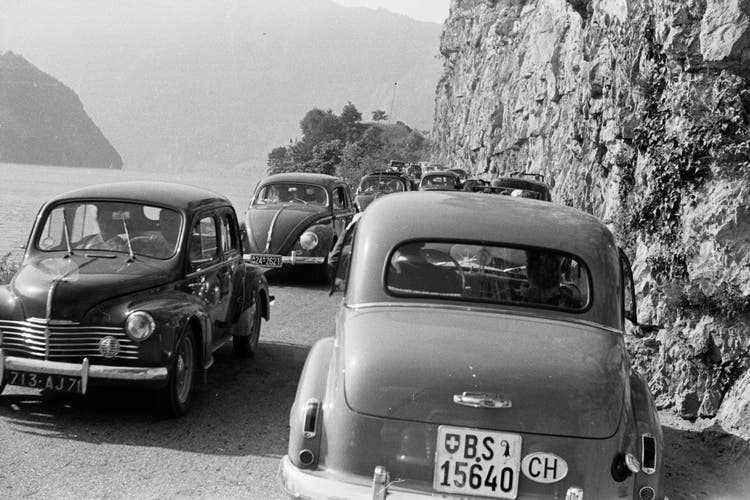
More traffic from the 1950s also meant more accidents.
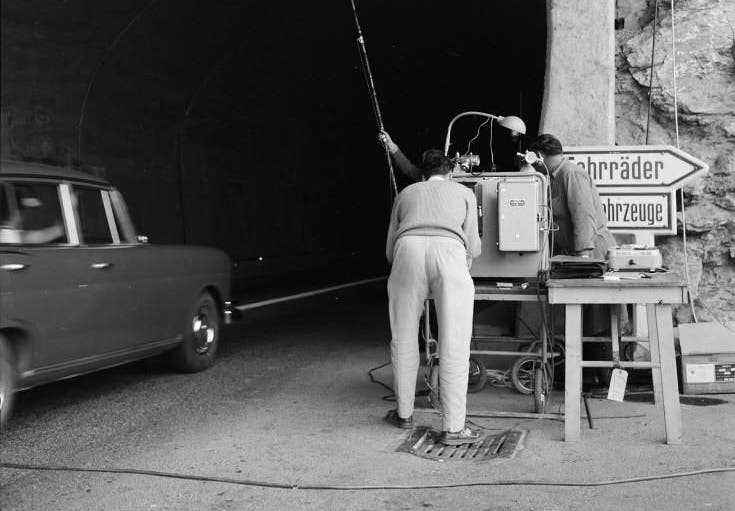
The expansion of Axenstrasse went hand in hand with improved safety precautions. (Exhaust gas measurement in front of a tunnel, undated.)
Rock falls in the 1980s led to renewed closures. In 1992, a rocky outcrop threatened to fall onto the road on the Schwyz section. The safety blast became a TV event, Swiss television reported live – and again the axis between Zurich and Ticino was closed for several months.
“Axenstrasse closed after a rockfall” was also read in all online media in 2019. Shortly thereafter: “Axenstrasse open again.” And then again a few days later: “Axenstrasse is closed again.” A 12-ton boulder just missed the road. And again, security and surveillance were the focus of the authorities.
Many fatal accidents over the years
The threatening tragedies were joined by the real ones, caused by human beings. There have been many fatal accidents over the decades. The Swiss media database is full of newspaper reports: “Death after head-on collision on Axenstrasse”, “Axenstrasse closed after tragic accident”, “Pedestrians killed on Axenstrasse”.
The accidents are all shocking. That’s why you often get a queasy feeling when you drive through the curves and galleries of Axenstrasse in your car.
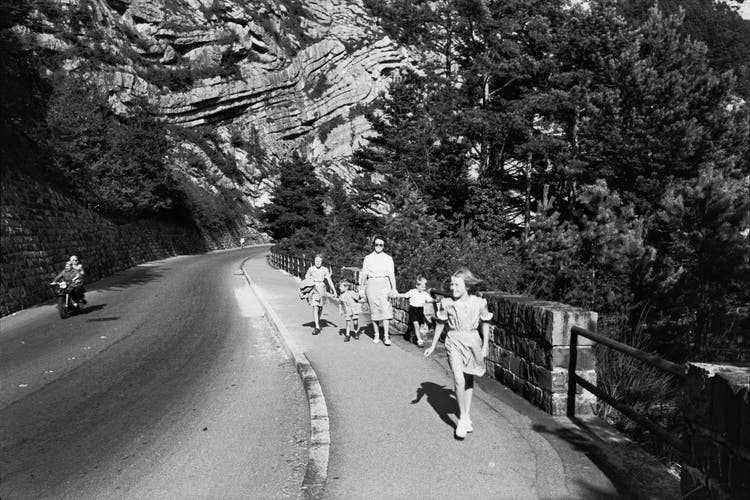
A family enjoys the excursion above Lake Uri. (Recorded around 1950.)
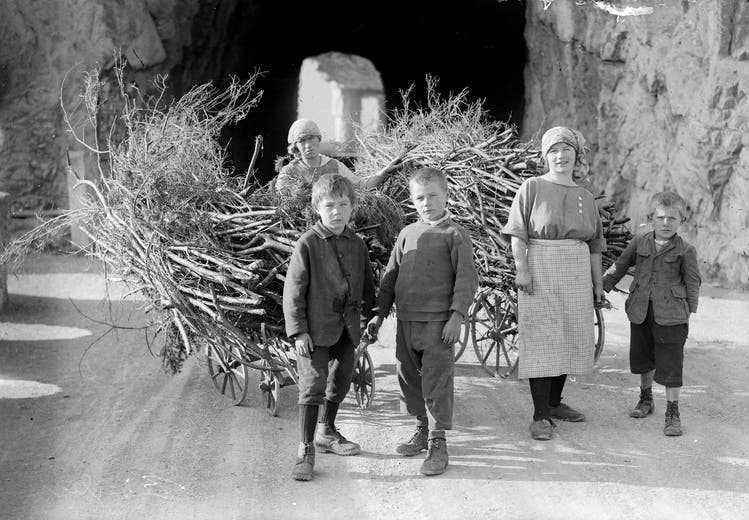
The boom in Uri came with the Axenstrasse. (Children stand in front of their loaded carts around 1924.)
It cannot be assumed that the tragic and spectacular accident of last Sunday will lead to fewer people driving on Axenstrasse in the future and switching to the motorway on the other side of the lake. Because suffering and tragedy are part of the history of the both romantic and rough road on Lake Uri. They make up their part of the fascination of the street.
The photographer
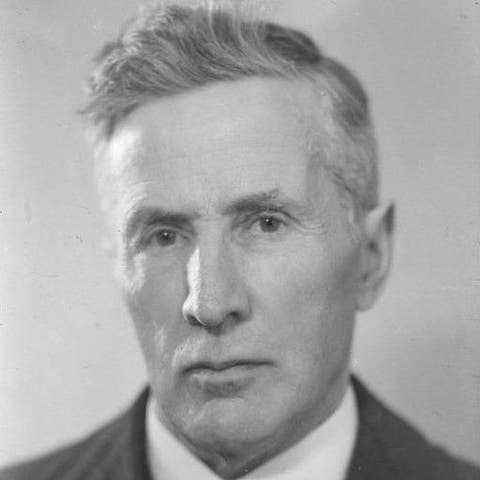
Michael Aschwanden
Michael Aschwanden from Uri was born in 1865 – the year the Axenstrasse was opened. The trained lithographer taught himself to take photographs. In the summer months of 1911 he began photographing passers-by on Axenstrasse. In 1917 he bought the “Spinnenloch” plot on Axenstrasse, where he ran a photography shop. Thousands of his photographs from the period between 1911 and 1939 have been preserved, many of which can be admired in the book “Unterwegs” (ed. Melk Imboden, 2003). Aschwanden had six children. He died in 1940.
